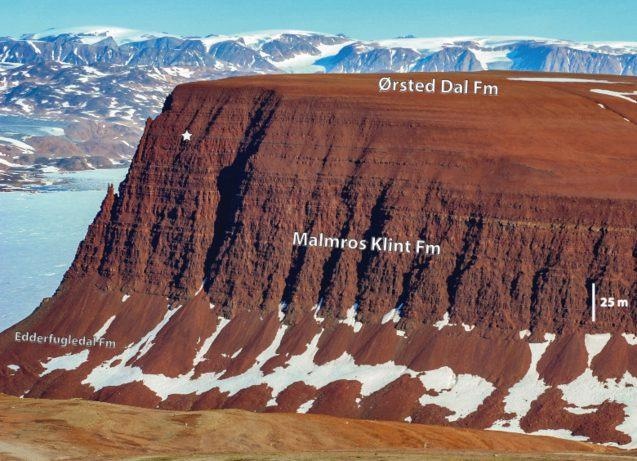Feb 16 2021
A new article has refined the estimates of when herbivorous or plant eating dinosaurs could have crossed North America on a northerly journey to reach Greenland, and pointed out an interesting climatic occurrence that could have aided these animals along the voyage.
 A cliff in Jameson Land Basin in central East Greenland, the northernmost site where sauropodomorph fossils are found. The labels point out several series of layers that helped the researchers precisely date the oldest sauropodomorph fossils in North America. Image Credit: Lars Clemmensen.
A cliff in Jameson Land Basin in central East Greenland, the northernmost site where sauropodomorph fossils are found. The labels point out several series of layers that helped the researchers precisely date the oldest sauropodomorph fossils in North America. Image Credit: Lars Clemmensen.
Recently published in the Proceedings of the National Academy of Sciences, the study was written by Dennis Kent, an adjunct research scientist from the Lamont-Doherty Earth Observatory at Columbia University, and Lars Clemmensen from the University of Copenhagen.
According to previous estimates, sauropodomorphs—a herd of plant eating, long-necked dinosaurs that included Brachiosaurus and Brontosaurus—reached Greenland sometime between 225 and 205 million years ago.
However, the new study carefully matched up old magnetism patterns present in rock layers at fossil locations throughout South America, New Jersey, Arizona, Greenland and Europe, and subsequently provided a more accurate estimate.
The study indicated that around 214 million years, sauropodomorphs appeared in what is now Greenland, and during that time, the continents were all linked together and formed the supercontinent, called Pangea.
Armed with this latest and more accurate estimate, the study authors faced one more question. According to fossil records, sauropodomorph dinosaurs initially appeared in Brazil and Argentina around 230 million years ago. But it was still an enigma as to why these dinosaurs took so long to expand into the Northern Hemisphere.
In principle, the dinosaurs could have walked from almost one pole to the other. There was no ocean in between. There were no big mountains. And yet it took 15 million years. It’s as if snails could have done it faster.
Dennis Kent, Adjunct Research Scientist, Lamont-Doherty Earth Observatory, Columbia University
Kent, also an Emeritus Professor at Rutgers University, estimated that if a group of dinosaurs had trekked just one mile each day, it would take less than two decades to make the voyage between South America and Greenland.
Interestingly, Earth was in the middle of a considerable dip in atmospheric CO2 close around the time the sauropodomorph dinosaurs would have been traversing 214 million years ago.
Until around 215 million years ago, the Triassic era had experienced very high levels of CO2 at approximately 4,000 parts per million (ppm)—around 10 times higher than today. However, sometime between 215 to 212 million years ago, the CO2 levels reduced by 50%, decreasing to around 2,000 ppm.
While the timing of both these events—the declining CO2 levels and the migration of sauropodomorphs—could be simply a coincidence, According to Kent and Clemmensen, there may a connection between these two events.
In the new article, the team has proposed that the milder CO2 levels could have helped to eliminate the climatic obstacles that probably confined the sauropodomorph dinosaurs in South America.
On planet Earth, regions surrounding the equator are humid and hot, whereas neighboring regions situated in low latitudes tend to be extremely dry.
According to Kent and Clemmensen, on a planet amplified with CO2 gas, the variations between those climatic belts could have been extreme—perhaps too adverse for the sauropodomorphs to traverse.
We know that with higher CO2, the dry gets drier and the wet gets wetter.
Dennis Kent, Adjunct Research Scientist, Lamont-Doherty Earth Observatory, Columbia University
About 230 million years ago, the extreme CO2 conditions could have probably made the arid climatic belts too dry to aid the migrations of large herbivorous animals that need to consume plenty of vegetation to live.
Similarly, the tropics could also have been locked into monsoon-like, rainy conditions that may not have been perfect for the sauropodomorph dinosaurs. There is not much proof that these animals ventured forth from the mid-latitude, temperate habitats they were acclimatized to in the Brazilian and Argentinean habitats.
However, when the CO2 consternations dropped 215 to 212 million years ago, maybe the arid areas became less dry and the tropical areas became milder.
There could have been certain routes, such as along strings of lakes and rivers, that would have helped sustain the plant eating dinosaurs along the 6,500-mile trek to Greenland, wherein their fossils are currently abundant.
During that early period, Greenland probably had a temperate climate almost the same as that of the current climate of New York state but with relatively milder winters, since polar ice sheets were not formed at that period.
Once they arrived in Greenland, it looked like they settled in. They hung around as a long fossil record after that.
Dennis Kent, Adjunct Research Scientist, Lamont-Doherty Earth Observatory, Columbia University
The concept that a drop in CO2 levels could have aided these dinosaurs to overcome a climatic barricade is speculative but credible, and it appears to be supported by the fossil record, Kent added.
Although sauropodomorph body fossils have not been detected in the arid and tropical regions of this time period—their footprints do turn up sometimes—indicating that the dinosaurs did not stay in those regions.
Kent now hopes to further explore this idea to gain a deeper understanding of the large CO2 dip, including what triggered it and how rapidly the CO2 levels decreased.